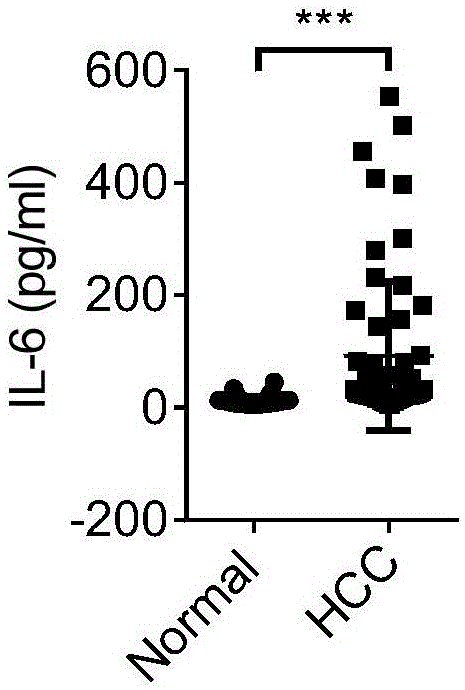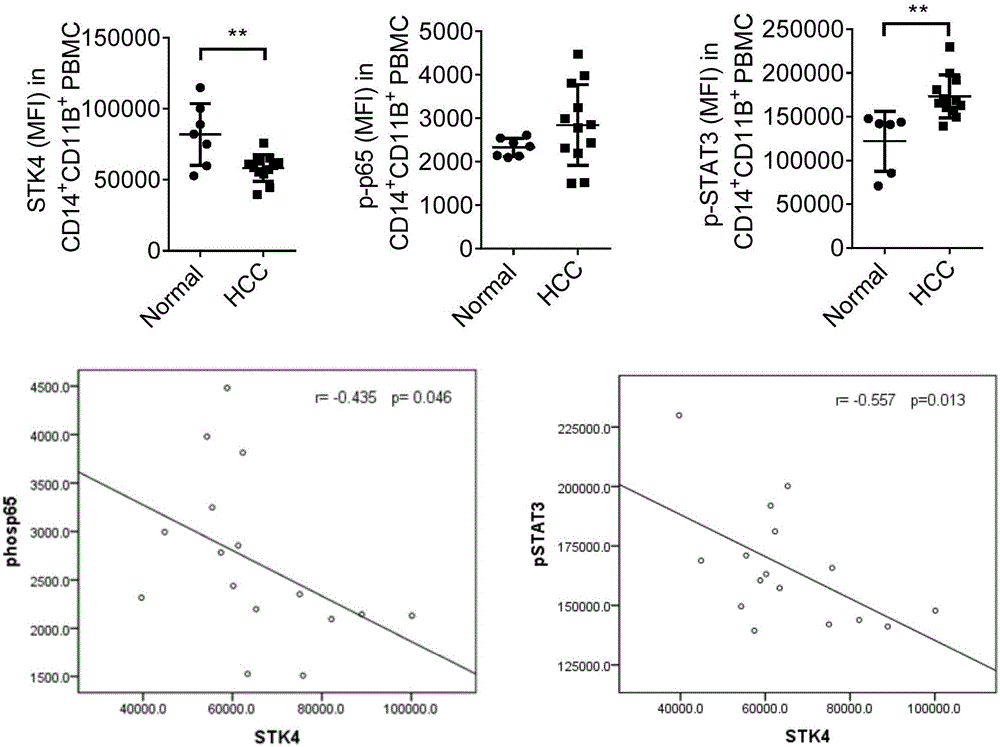Marker for diagnosis of inflammation-associated HCC and application thereof
A technique for diagnosing markers and liver cancer, which is applied in the field of disease diagnosis and can solve problems such as unsatisfactory differentiation techniques
- Summary
- Abstract
- Description
- Claims
- Application Information
AI Technical Summary
Problems solved by technology
Method used
Image
Examples
Embodiment 1
[0061] Example 1, STK4 protein and IL-6 protein levels in liver cancer mice
[0062] Using DEN+CCl 4 + LPS induces the process of inflammation-related liver cancer. DEN was injected intraperitoneally into 6-week-old wild-type mice. In the third week after injection, low-dose LPS was injected every day, and in the fourth week, CCl was given once a week. 4 Injection and observation after 12 weeks. After 11 months, the liver was removed, the lymphocytes in the liver were separated by Percoll, and the F4 / 80 and STK4 were stained by FACS flow cytometry, and the protein level of STK4 in macrophages was detected. At the same time, the blood was coagulated at room temperature for 60 minutes after eyeball blood collection, centrifuged at 3000 rpm / min for 20 minutes, and the supernatant serum was collected. The content of IL-6 in serum was detected by ELISA kit.
[0063] The result is as figure 1 , untreated normal control group (Veh) and DEN+CCl 4 There were significant difference...
Embodiment 2
[0065] Example 2, the level of IL-6 in the peripheral blood of patients with liver cancer
[0066] Plasma was collected from 40 normal healthy people and 59 liver cancer patients. 3ml of blood from normal healthy people or patients with liver cancer collected in anticoagulant tubes was separated by Ficoll, and the uppermost layer of plasma was taken, and the content of IL-6 in the plasma was detected by ELISA.
[0067] The result is as figure 2 , The plasma level of IL-6 in patients with liver cancer was detected by ELISA method; while the level in normal healthy people was extremely low, the highest level was less than 20pg / ml, and there was a significant difference between the two.
Embodiment 3
[0068] Example 3. Combined detection of STK4, p-p65 and p-STAT3 levels in peripheral blood mononuclear cells of patients with liver cancer, application in individualized treatment
[0069] Peripheral blood mononuclear cells were collected from 7 normal healthy people and 12 liver cancer patients. 3ml of blood collected from normal healthy people or liver cancer patients was collected by anticoagulant tube, separated by Ficoll, and the middle layer mononuclear cells were collected, and CD14 was detected by FACS flow cytometry + CD11b + Contents of STK4 and p-p65 and p-STAT3 in peripheral blood mononuclear cells.
[0070] The result is as image 3 , in patients with liver cancer CD14 + CD11b + In peripheral blood mononuclear cells, CD14 was detected by flow cytometry + CD11b + The expression level of STK4 in peripheral blood mononuclear cells is lower than that of normal people. On the contrary, both phos-p65 and phos-STAT3 were higher than normal.
[0071] Moreover, usi...
PUM
 Login to View More
Login to View More Abstract
Description
Claims
Application Information
 Login to View More
Login to View More - R&D
- Intellectual Property
- Life Sciences
- Materials
- Tech Scout
- Unparalleled Data Quality
- Higher Quality Content
- 60% Fewer Hallucinations
Browse by: Latest US Patents, China's latest patents, Technical Efficacy Thesaurus, Application Domain, Technology Topic, Popular Technical Reports.
© 2025 PatSnap. All rights reserved.Legal|Privacy policy|Modern Slavery Act Transparency Statement|Sitemap|About US| Contact US: help@patsnap.com



